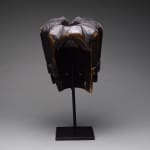Sande Society Mende Helmet Mask, 20th Century CE
Wood
26.7 x 17.8 x 16.5 cm
10 1/2 x 7 x 6 1/2 in
10 1/2 x 7 x 6 1/2 in
DE.062 (LSO)
Further images
This powerful helmet mask has been attributed to the Mende people of Sierra Leone. It pertains to the Sande women’s initiation society, the only all-female masking society in Africa. While...
This powerful helmet mask has been attributed to the Mende people of Sierra Leone. It pertains to the Sande women’s initiation society, the only all-female masking society in Africa. While designed along traditional lines, it seems to be a later interpretation, to judge from the tone of the wood, the preservation and also the unusual interpretation of stylistic elements. It has the traditional small face, but the symmetrical nature of the older pieces is absent, as is the definition of the face’s edges. The features are also more robustly rendered than is usual. The hair is exceptionally complex, and is very pleasing when viewed from a vertical elevation. Unusually, both it and the face are decorated with incised markings, bands and abstract patterns. The neck rings that usually appear on such masks are absent. The facial appearance of the mask has some design elements in common with Yoruba Gelede masks, although the monochromy stands against this.
While currently being marginalized by pressure from Islamic conventions concerning the figurative in art, Mende society was originally controlled by the Sande group. They were charged with responsibility for a sacred medicine known as halei, which was bestowed by deities upon the Mende and their close neighbours, the Gola. The power of halei was displayed during prolonged “Now” dancing masquerades, which were performed using these masks and long, dark costumes, although the actual secrets of halei were never divulged. There were various levels of Sande initiation, each with its own mask. The more ornate the mask, the higher the grade. Once made and endowed with magic through strategic application of oil and halei materials, the mask stays with the owner until she retires, dies, or is promoted.
This is a striking piece of African art.
While currently being marginalized by pressure from Islamic conventions concerning the figurative in art, Mende society was originally controlled by the Sande group. They were charged with responsibility for a sacred medicine known as halei, which was bestowed by deities upon the Mende and their close neighbours, the Gola. The power of halei was displayed during prolonged “Now” dancing masquerades, which were performed using these masks and long, dark costumes, although the actual secrets of halei were never divulged. There were various levels of Sande initiation, each with its own mask. The more ornate the mask, the higher the grade. Once made and endowed with magic through strategic application of oil and halei materials, the mask stays with the owner until she retires, dies, or is promoted.
This is a striking piece of African art.







